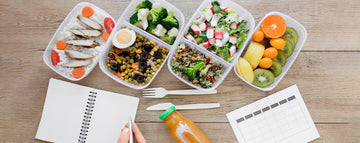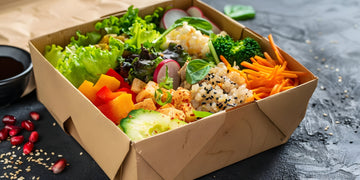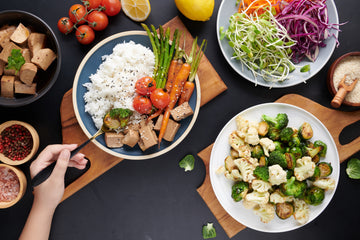It is a common misconception that weight loss is simply the result of eating less and exercising more. In reality, long-term success comes from making thoughtful choices about what you eat and how your meals are structured. The right combination of foods can control hunger, stabilize energy levels, and support overall health, without feeling restricted.
When planning or choosing healthy meals for weight loss, it’s important to focus on balance, variety, and sustainability. From high-protein meals to fiber-rich vegetables and convenient delivery options, here’s what to consider in crafting an effective plan.
Building the Foundation of a Weight Loss Meal Plan
A successful weight loss diet doesn't mean cutting out entire food groups or surviving on bland salads. Instead, it’s about creating nutrient-dense, portion-controlled, and satisfying meals. Weight management begins with a healthy diet that consists of:
-
Protein for satiety and muscle support – Lean chicken, fish, tofu, beans, and lentils keep you fuller for longer.
-
Fiber for digestion and fullness – Vegetables, fruits, and whole grains add volume to meals without excess calories.
-
Healthy fats for balance – Nuts, seeds, avocados, and olive oil, along with other healthy fats, provide long-lasting energy.
-
Complex carbohydrates for energy – Quinoa, brown rice, and oats fuel the body.
This combination ensures that meals feel complete and enjoyable while still aligning with weight loss goals.

The Power of High-Protein Meals for Weight Loss
Protein plays a central role in weight management. Studies consistently show that people who eat high-protein meals for weight loss experience reduced cravings and improved satiety. Protein also helps preserve lean muscle mass, which keeps metabolism strong.
Examples of effective high-protein options include:
-
Grilled salmon paired with roasted vegetables
-
A quinoa and chickpea salad with olive oil
-
Tofu stir-fry with brown rice
-
Chicken and spinach salad topped with nuts
Including protein in every meal not only helps with hunger control but also improves recovery, focus, and energy throughout the day.
The Role of Salads and Vegetables
Salads are often considered the classic “diet food,” but when done right, they can be so much more. Salad meals provide essential micronutrients, fiber, and antioxidants, making them a powerful component of any weight loss strategy.
The key is to make salads balanced and filling:
-
Start with dark leafy greens for nutrient density.
-
Consider adding grilled chicken, tofu, or beans as a source of protein.
-
Include healthy fats such as avocado or seeds.
-
Use light, wholesome dressings rather than heavy cream-based ones.
Salads don’t have to be side dishes. They can serve as nutrient-packed mains that support satiety and satisfaction.
Considering Vegetarian Meals for Weight Loss
It is also possible to lose weight by eating a plant-based diet. Vegetarian meals are often lower in calories while being rich in fiber, making them naturally filling. Foods like lentils, beans, quinoa, and roasted vegetables provide protein and nutrients without excess fat.
The following may be included in a vegetarian weight loss meal plan:
-
Lentil soup with whole-grain bread
-
Quinoa and roasted vegetable bowls
-
Chickpea salad wraps with hummus
-
Stir-fried tofu with seasonal greens
These meals highlight the flexibility of plant-based eating, proving that weight loss doesn’t have to mean restriction or boredom.
When Meal Delivery Can Support Your Goals
For many people, the biggest challenge isn’t knowing what to eat; it’s staying consistent. As a result of work, family, and social commitments, preparing nutritious meals daily may seem impossible. That’s where weight loss meal delivery becomes especially valuable.
Meal delivery services provide:
-
Pre-portioned, ready-to-eat meals designed for balance
-
High protein meal plan options that align with weight goals
-
Variety of choices, including vegetarian, salad-focused, and nutrient-rich meals
-
Time savings that reduce stress and decision fatigue
Meal delivery eliminates the barriers to shopping, prepping, and portioning, thereby facilitating long-term weight loss.
Healthy Foods to Prioritize
No matter which approach you take, some healthy foods should remain staples in any weight loss meal plan:
-
Leafy greens like spinach, kale, and arugula
-
Protein-rich foods include tofu, lentils, fish, and chicken
-
Complex carbohydrates like oats, quinoa, and sweet potatoes
-
Healthy fats from nuts, seeds, and olive oil
-
Fruits such as berries, apples, and pears provide a natural sweetness
These foods not only aid in weight management but also improve digestion, immunity, and overall vitality.

A Sustainable Approach to Weight Loss
The most effective weight loss plan isn’t the one that promises the fastest results, but the one you can maintain long-term. Often, quick fixes and crash diets lead to weight gain and stress. Instead, focus on:
-
Balanced meals that are enjoyable and satisfying
-
Consistent routines supported by meal planning or delivery
-
Flexibility that allows occasional treats without guilt
-
Nutrient-dense foods that fuel both body and mind
By focusing on sustainability rather than restriction, weight loss becomes a natural outcome of healthier choices.
Summary
Choosing the right weight loss meals comes down to balance, variety, and convenience. Whether you’re building your plan or exploring weight loss meal delivery, consider the role of protein, vegetables, salads, and whole foods in your daily routine.
The goal isn’t just to shed pounds quickly but to create a relationship with food that supports long-term health, energy, and confidence. By prioritizing healthy meals for weight loss, you’re not just changing your plate; you’re transforming your lifestyle.




